 |
||
|
||
| ||
"Hercules is the greatest Hellenic hero which took a remarkable place among the Hellenic and the Roman gods. Among all deeds ascribing to him by the mythology (12 main labors) there was entering the Underworld, where he brought out from a three-head hound Cerberus, the guardian of the entrance to Hades".  There are a lot of myths and legends concerning Hercules, but one unforgettable image of this hero is a portrait of the Greek handsome athlete depicted naked. So well, a certain time ago, when computers were giants with tiny brains, one company decided to tread out their own path to the light future of today's PC, and importance of this affair was marked in the name. So, that was a beginning step of the Hercules Computer Technology, which later was called just Hercules Computer. The company concentrated their efforts on a new direction of video-subsystem for PC. But the time was going, a pioneer in the video-subsystem field became a usual manufacturer of video cards based on the third companies' chips. By 1999 the company chose graphics processors from NVIDIA (Riva TNT2) and S3 (Savage4). Hercules, though, was still trying to surprise users with a non-standard approach to video card production. The release of the last video card (why last? - see below) - Hercules Dynamite TNT2 Ultra was marked with a great demand on the one hand, and small production volume on the other hand. The matter is that Hercules Computer selected for this card NVIDIA Riva TNT2 Ultra chips and installed only those which worked flawlessly at 175 MHz (the rated frequency for these processors is 150 MHz). And memory frequency was set to 200 MHz instead of 183 MHz rated. All this required additional expenses that's why these cards cost higher than the competitors (besides, Hercules always paid close attention to quality, and their cards were always at the level of well-known brands). But the trouble came later. Chipsets which didn't proved their might were installed on the usual Riva TNT2 - these cards were much more in quantity than the Ultra's. But nobody desired to buy them, everybody wanted a famous Hercules's Ultra. The deliveries on the pre-paid orders were smashed, the company accumulated a great number of unsold Riva TNT2 cards. All this resulted in bankruptcy. In August 1999 when Hercules Computer announced bankruptcy, all their properties were given to creditors, the stocks were sold out quickly at low prices in order to pay off debts, and... that's all. I should say that in 1999 a European company ELSA expressed a desire to unite with Hercules, but it failed. By the autumn Hercules Computer was at the edge of existing, it had only a trademark and an office. And at that moment the company went through the second birth, but for that time - as a department of Guillemot concern. The most powerful magnate of France bought the company at $1.5 million and became an owner both of the trademark and all the remains. And today nearly all Guillemot's video cards are released under the trademark Hercules. Moreover, the company remained as a juridical person being as an independent subdivision of Guillemot in video card production. That's why further I will name Hercules as a manufacturer implying that this company and the trade mark belong to Guillemot. Now we are coming to consideration of one video card of this company. It is Hercules 3D Prophet II Pro based on the NVIDIA GeForce2 Pro. Unlike the NVIDIA GeForce2 Ultra, video cards on the GeForce2 Pro set have lower cost showing at the same time rather good speed results. But why - set? Because such boards are equipped with 200-MHz GeForce2 GTS which has a faster memory with 5 ns access time, what corresponds to 200 (400) MHz. It means that the difference from GeForce2 GTS is only in a faster memory. We already considered several similar video cards and said that all of them are rather good at overclocking reaching in 32-bit color a performance level of the GeForce2 Ultra, and sell at the same time at the lower price. For the beginning of February the cards on this GPU cost $275-290. Of course, it's a bit high, but still it is much cheaper than $450 for the NVIDIA GeForce2 Ultra card. BoardThe card has AGP x2/x4 interface, 64 MBytes DDR SDRAM located in 8 chips on the right side of the PCB.  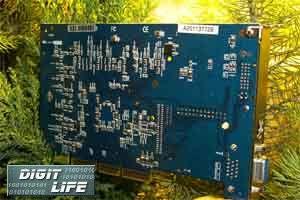 The memory chips are produced by EliteMT 5 ns and are intended for 200 (400) MHz. 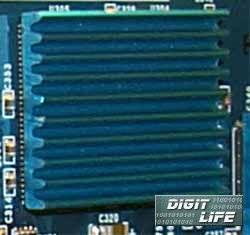 This is a an actual working frequency as well. The design of the board differs from analogs in a heatsink installed by Hercules on all memory chips. Undoubtedly, one of the fastest memory modules dissipates a lot of heat, but according to the experience of working with analogs, which lack for any heatsinks, DDR-memory with 5 ns access time works perfectly without radiators. Moreover, a fan blowing on the board allows overclocking it from 200 to 240 MHz. The board completely follows the reference design. A bright feature of the Hercules 3D Prophet II Pro is its color. Such sky-blue color is typical for Gigabyte cards, a business card of Hercules is a combination of such color of PCB with a softer blue color of heatsinks on the memory chips. 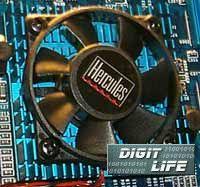 The graphics processor is equipped with an active cooler, which efficiency is rather high. The fan is black and looks like a steering-wheel on the background of the blue radiator. The heatsink itself has both pins and fins. The video card is supplied with a daughter board with TV-out, but it lacks for a connector for digital monitors (DVI). The card was received in OEM-package where apart from a CD with drivers and a soft DVD-player PowerDVD 2.5 we found S-Video-to-RCA adapter, what allows you to use TV-out in case you do not have video equipment with S-Video-connectors. Of course, Retail-package exists as well, but we do not know what's included there. OverclockingThe general formula of overclocking is the following: you should provide proper cooling, do not overclock too much, and the performance will increase. Note that always while overclocking a video card you'd better to insert an additional cooler (at least a fan blowing on the memory modules). The boards of the GeForce2 Pro class are equipped with a fast 5 ns memory capable of operating at 200 (400) MHz. The experience says that the memory will allow to overclock maximum by 30 MHz, but on such boards we already obtained 240 (480) MHz. This card managed to reach 240 (480) MHz memory frequency, but in that case we saw some artifacts, that's why I had to decrease the speed down to 238 (476) MHz, and during 22 hours of continuous testing we didn't notice anything bad. The GPU was working flawlessly at 240 MHz what is a record among GeForce2 Pro-cards. With a hope to receive a considerable speed with such overclocking, we will show you how GPU frequency influences the overall performance, i.e. we will check the balance of the video cards of this class. Note that while overclocking we used an additional fan mounted in the case of the test machine. Installation and driversThe test system configuration:
Unfortunately, the video card is shipping together with drivers of rather old version - 5.33. That's why we downloaded the latest drivers of 6.35 version implemented on the base of the reference ones from NVIDIA. This software completely follows the reference drivers in settings. But since this version was followed by an official release of drivers from NVIDIA, we tested the card on this 6.50 version (VSync was off). For comparison we used results of the following video cards: ATI RADEON 64 MBytes (Retail-package, 183/183 MHz), AOpen PA256 Deluxe, Leadtek WinFast GeForce2 Pro and ASUS AGP-V7700 Pro. Test resultsAs for 2D-graphics I have nothing new to say here. In the previous review on Inno3D Tornado GeForce2 Ultra I gave detailed information on this issue. 2D corresponds to a rather good level. Once again I should remind you: before blaming the card, check whether your monitor corresponds to the claims you set for you video card. Now comes an estimation of the card's performance in 3D. The following programs were used:
Quake3 ArenaThe test on the standard demo002 was carried out in two modes: Fast (shows card's work in 16-bit color) and High Quality (shows card's work in 32-bit color). 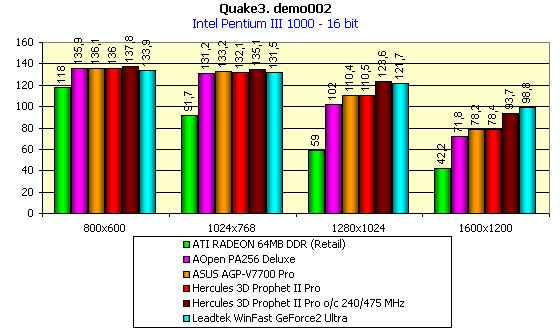  ExpendableWe will use this game to show the card's speed in Direct3D. 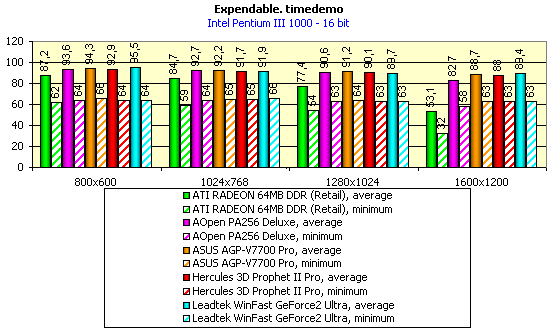 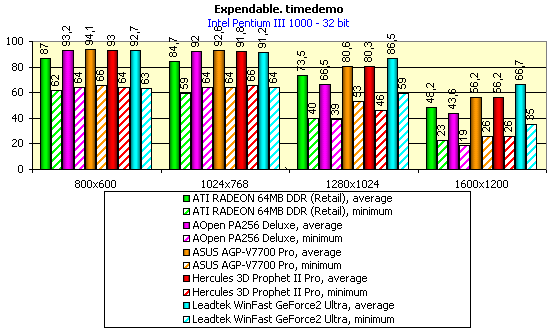 The Hercules 3D Prophet II Pro performed quite good, at the level of the competitor ASUS AGP-V7700 Pro, having left others too far behind. Overclocking yields marked increase in speed. Note that the overclocked Hercules 3D Prophet II Pro outperformed the Leadtek WinFast GeForce2 Ultra nearly at all resolutions except 1600X1200. Balance analyses of the video card with Quake3 ArenaAs you might know, video cards based on the NVIDIA GeForce2 are not well-balanced, i.e. the memory bandwidth cuts a great bite of the GPU's potential. Below you will see how strong a memory working speed can influence the overall performance. A simple way to do it is to fix GPU's clock speed and increase memory frequency. But this doesn't give a full-value picture, since memory overclocking is limited too much. That's why I took the opposite way: I fixed memory frequency at the highest possible level (overclocking) and decreased GPU frequency in order to determine how much it would affect the performance of the whole system. The chipset speed was reduced from 240 (overclocking) to 150 MHz with the memory working at 237 (475) MHz. 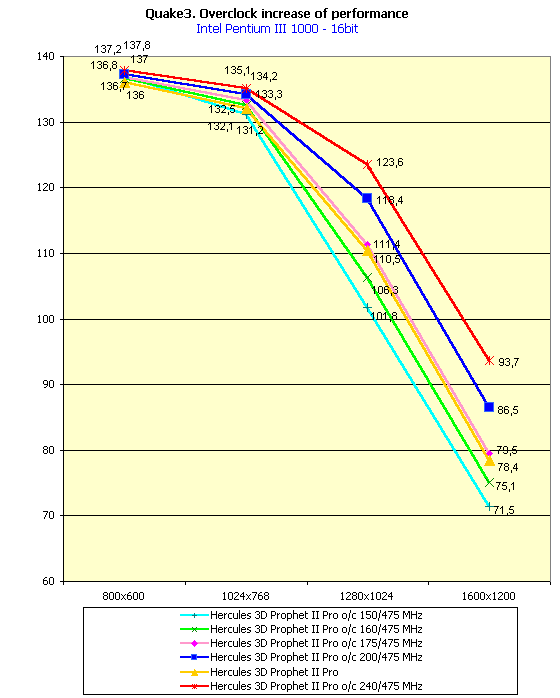 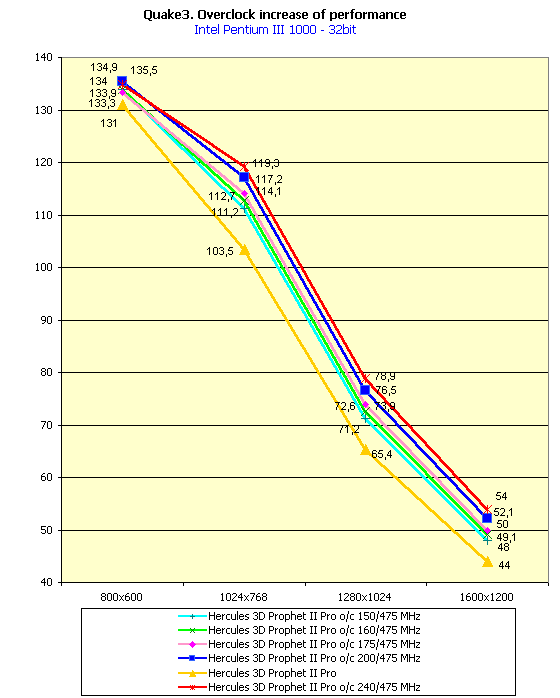 Interestingly is that in 16-bit color GPU frequency influences stronger than in 32-bit color since the bottleneck in the form of the memory bandwidth slows down the card operation, and first of all in TrueColor. Nevertheless, operating speed at 175/237 (475) MHz turned to be a bit higher than the values at the rated 200/200 (400) MHz. 32-bit color revealed a complete disbalance. Look, even the chipset operation at 150 MHz with the memory working at 237 (475) MHz has poured into much higher speed than the regular mode. When reducing GPU frequency the overall performance fell just slightly. So, even with 230-MHz DDR-memory (which is installed on NVIDIA GeForce2 Ultra cards) it makes no sense to lift GPU frequency, and even 150 MHz on the chipset will yield nearly the same performance in 32-bit color. Although the NVIDIA GeForce2 Pro is the most balanced card of the whole GeForce2 series, it still has a long way to go. The potential of such GPU is still to much limited by the memory bandwidth. Well, the summary on the Hercules 3D Prophet II Pro card performance:
ConclusionTo release a product is only half the work. In order it to sail easily on the market, it needs a good captain. Computer hardware has its own captain - it is those sources of information which form an opinion on it, and certainly with the examples of practical use. Here you can include both testers-observers examining new products on the market, and users dealing with it and contributing to the public opinion. Exactly this kind of information makes a certain device either popular or not. Of course, the price plays a great role, but price parameters are put into the information at the stage of forming the opinion. So, taking exactly our video card - Hercules 3D Prophet II Pro, I'd like to notice that it is a high quality product which yields to none of its competitors. Such cards are very popular thanks to the price lower than that of the counterparts. More detailed comparison characteristics of video cards of this and other classes you can find in our 3Digest. Highs:
Lows:
Write a comment below. No registration needed!
|
Platform · Video · Multimedia · Mobile · Other || About us & Privacy policy · Twitter · Facebook Copyright © Byrds Research & Publishing, Ltd., 1997–2011. All rights reserved. |